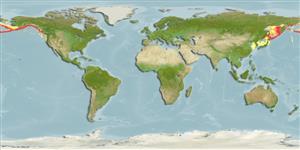sub class Elasmobranchii (ฉลามและกระเบน) (sharks and rays) >
Rajiformes (Skates and rays) >
Arhynchobatidae (Softnose skates)
Etymology: Bathyraja: Greek, bathys = deep + Latin, raja, -ae = a ray (Raja sp) (Ref. 45335); aleutica: Named for its type locality, Aleutian Islands..
More on author: Gilbert.
Environment: milieu / climate zone / depth range / distribution range
นิเวศวิทยา
เกี่ยวกับทะเล,น้ำเค็ม สัตว์หน้าดินในเขตน้ำลึก; ระดับความลึก 15 - 1602 m (Ref. 50550). Deep-water
North Pacific: from the Bering Sea, south to Cape Mendocino, northern California, and far west to northern Japan.
Length at first maturity / ขนาด / น้ำหนัก / Age
Maturity: Lm 122.0, range 112 - 132 cm
Max length : 161 cm TL เพศผู้/กระเทย; (Ref. 56527); 154.0 cm TL (female); น้ำหนักสูงสุดที่มีการรายงาน: 23.1 kg (Ref. 56527)
Short description
สัณฐานวิทยา | ความยาวต่างๆ
This large, rhomboidal skates (1,540 mm TL) have long head length 16.7-24.3% TL) and rounded pectoral apices; interdorsal space is large (1.3-3.1% TL); claspers short and stubby, with tip rounded and not bulbous, with weakly defined pseudosiphon, the dorsal lobe has a short pseudorhipidion, U-shaped cleft, while ventral lobe with a rounded projection; teeth in 34-42 rows on upper jaw, and 32-38 rows on lower jaw; pectoral radials 90; pelvic fins 22; total vertebrae 152; dorsal surface of body with fine prickles, becoming larger on the tail, also with thorns, with males having alar thorns, no malar thorns, middorsal thorns developed and high in number (4-11), nuchal thorns strong (3-5), scapular and tail thorns present, interdorsal thorns weak (1-2). Colouration: dorsal dark brown to grey, dark spots on pectorals, often with ocellus on either pectoral fin, while ventral white, with darker coloration on the snout, gills, disc margins, pelvics, and underside of the tail (Ref. 126515).
Found in deep waters, on outer continental shelf and upper slope, often over muddy sediments. Reported to feed mainly on benthic crustaceans, including shrimps and crabs, and secondarily on bony fishes (Ref. 126515). Oviparous. Distinct pairing with embrace. Young may tend to follow large objects, such as their mother (Ref. 205). Size at maturity for males 113 cm TL and 125 cm TL for females with males growing to at least 150 cm TL and females grow to about 154 cm TL; reported size at birth is 12-15 cm TL (Ref. 126515). Eggs are deposited in sandy or muddy flats (Ref. 205). Egg capsule measures 120-136 mm long and 73-90 mm wide (Ref. 41249, 41253); golden brown in color, and covered with coarse, striated, and anteriorly-directed prickles, giving it a velvety texture; the cases are with long, curved horns at each corner, with the anterior horns being short and these horns taper and become thin and filamentous at their ends (Ref. 126515).
Oviparous, paired eggs are laid. Embryos feed solely on yolk (Ref. 50449). Distinct pairing with embrace. Young may tend to follow large objects, such as their mother (Ref. 205).
Knuckey, J.D.S. and D.A. Ebert, 2022. A taxonomic revision of Northeast Pacific softnose skates (Rajiformes: Arhynchobatidae: Bathyraja Ishiyama). Zootaxa 5142(1):1-89. (Ref. 126515)
IUCN Red List Status (Ref. 130435)
Threat to humans
Harmless
Human uses
ข้อมูลเพิ่มเติม
อ้างอิงการเพาะเลี้ยงสัตว์น้ำประวัติการเพาะเลี้ยงสัตว์น้ำสายพันธุ์พันธุศาสตร์ElectrophoresesอัตราพันธุกรรมโรคการแปรรูปNutrientsMass conversion
เครื่องมือ
Special reports
Download XML
แหล่งที่มาจากอินเตอร์เน็ต
Estimates based on models
Preferred temperature (Ref.
123201): 1.3 - 5.1, mean 2.3 °C (based on 239 cells).
Phylogenetic diversity index (Ref.
82804): PD
50 = 0.5000 [Uniqueness, from 0.5 = low to 2.0 = high].
Bayesian length-weight: a=0.00316 (0.00214 - 0.00467), b=3.11 (2.99 - 3.23), in cm total length, based on LWR estimates for this species & Genus-body shape (Ref.
93245).
ระดับชั้นอาหาร (Ref.
69278): 4.1 ±0.76 se; based on food items.
ความสามารถในการกลับคืนสู่ปกติ (Ref.
120179): ต่ำ, เวลาต่ำสุดที่จะทำให้ประชากรเพิ่มขึ้นเป็น 2 เท่าใช้เวลา 4.5 - 14 ปี (Fec assumed to be <100).
Fishing Vulnerability (Ref.
59153): Very high vulnerability (90 of 100).
